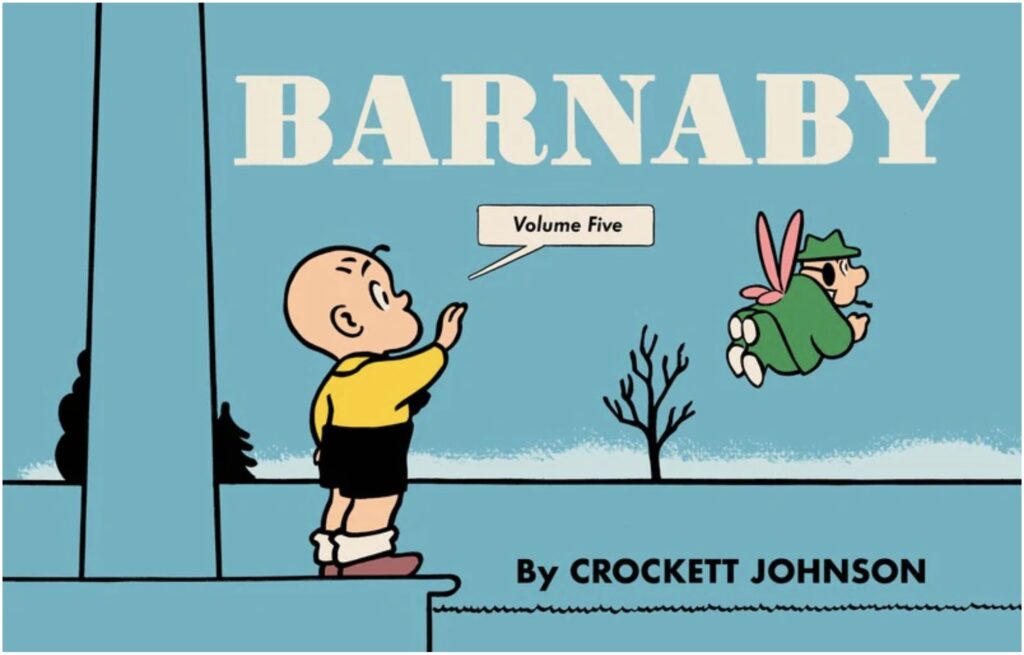
Crockett Johnson, Barnaby, Volume Five: 1950-1952. Co-edited by Philip Nel and Eric Reynolds. Foreword by Ron Howard. Essays by Susan Kirtley and Crockett Johnson. Biographical Essay and Notes by Philip Nel. Design by Daniel Clowes. Seattle, WA: Fantagraphics Books, on sale March 11, 2025.
- “[Barnaby] radiates human warmth and whimsy . . . [T]he artist’s brilliantly written characters . . . keep their feet planted in the all-too-real world of 1940s America while flying off on pink wings into one of the greatest fantasy strips ever made.” — Art Spiegelman
- “Highly verbal and quietly unexpected, the strip is a clear antecedent of the sort of comic situations experienced by Calvin and Hobbes — and the visuals predict Johnson’s own Harold with his purple crayon. Cleverly absurd.” — School Library Journal
- “Johnson’s strict and sharp lines, along with an ever-consistent typeface, give the strip a smooth and accessible appearance, appealing to both kids and adults. This [series] is also filled with the history of the strip and background on Johnson, giving testament to the weirdness and joy of childhood, and the eternal struggle to be yourself.” — Publishers Weekly
- Read “Interview: Philip Nel & Eric Reynolds on Crockett Johnson’s Barnaby from Fantagraphics,” at Westfield comics blog!
- Read my thoughts on publishing Barnaby Volume One, at Nine Kinds of Pie (my blog).
- Unboxing video for this book!
- Learn more about Crockett Johnson & Barnaby:
- Read my “Boredom, blacklisting or new beginnings? Why Crockett Johnson ended Barnaby“ in The Comics Journal (11 Feb. 2025) — this is adapted from the afterword to Barnaby, Volume 5.
- Read my “Crockett Johnson and the Invention of Barnaby“ in The Comics Journal (22 Apr. 2013).
- Read my “Before Barnaby: Crockett Johnson Grows Up and Turns Left” in The Comics Journal (26 Sept. 2012).
- Read my biographical essay on Crockett Johnson (pdf), which appeared in the now defunct Comic Art. In addition to being the most thorough biography of Johnson (prior to the publication of my full-length biography, listed below), the essay is fully illustrated (thanks to generous individuals and special collections).
- Visit my Crockett Johnson Homepage.
- Order the book from Fantagraphics.
- Order the book from Barnes and Noble.
- Order the book from Bookshop.org.
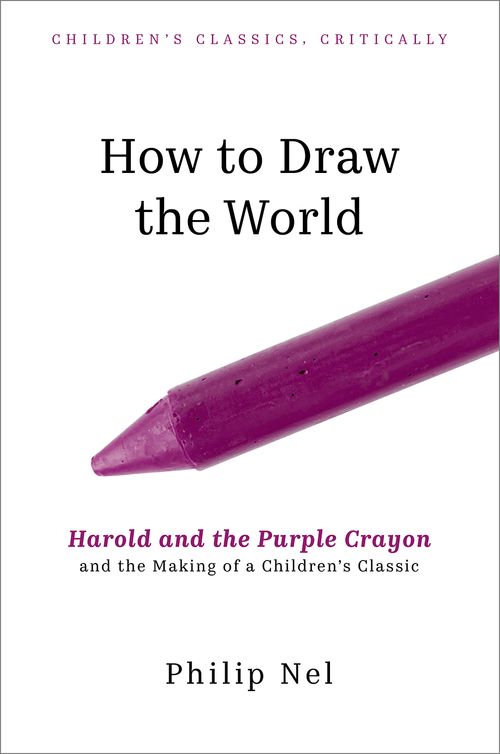
Philip Nel, How to Draw the World: Harold and the Purple Crayon and the Making of a Children’s Classic. Oxford University Press, December 2024.
- Winner of the 2025 PROSE Award in Literature from the Association of American Publishers.
- “Philip Nel’s enlightening book, How to Draw the World: Harold and the Purple Crayon, and the Making of a Children’s Classic, reads as though Nel himself were using a magic crayon to explore the importance of creativity. His book is a remarkable biography and autobiography, a creative analysis of Crockett Johnson’s marvelous works. Nel captures their essence and significance for young and old.” — Jack Zipes, author of Ernst Bloch, The Pugnacious Philosopher of Hope and The Original Bambi: The Story of a Life in the Forest
- “Nel praises, properly, Johnson’s purple prose and pictures. A perfect book for reading under a purple moon.” — Lane Smith, Caldecott Honor winner & author and illustrator of the New York Times bestseller It’s a Book
- “Harold drew a world of possibilities for all us childhood dreamers. Now Phil Nel draws us into the life of Harold’s creator–in all its scribbly contours. A delightful portrait.” — Scott McCloud, author of Understanding Comics: The Invisible Art and Making Comics: Storytelling Secrets of Comics, Manga and Graphic Novels
- “Insightful, lyrical, and [a] profoundly researched read . . . an inspired and fascinating look at a popular children’s picture book.” — Kirkus Reviews
- “A loving, scholarly ode to a children’s literature classic.” — Publishers Weekly
- More about Harold!
- “Turn off AI. Pick up a crayon.” The Oxford University Press Blog, 10 Oct. 2025.
- “His crayon is purple – but is Harold a Black boy?,” The Conversation, 16 Aug. 2024. This is adapted from the book.
- “The Purple Crayon on the Big Screen,” School Library Journal, 8 Aug. 2024. This is a review of the recent Harold movie.
Everything you’ve ever wanted to know about Harold and the Purple Crayon — or all that fits in a conversation between me and Ellen Duthie of Madrid’s Wonder Ponder Publishing, publishers of Harold in Spanish and in Catalan:
Unboxing video for How to Draw the World:
- Beth Golay, “Philip Nel on ‘How to Draw the World: Harold and the Purple Crayon and the Making of a Children’s Classic'” Marginalia podcast, 2 Jan. 2025
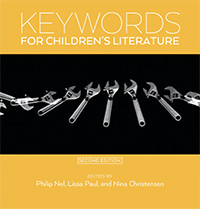
Philip Nel, Lissa Paul, and Nina Christensen, editors, Keywords for Children’s Literature, Second Edition. New York University Press, 2021.
- “This second edition is truly dazzling in its scope and ambition, stretching well beyond the bounds of the landmark first edition. It succeeds marvelously at its editors’ goal of being ‘generative rather than definitive’ and the international and multilingual scope produces thrilling new insights, not just about ways in which ‘etymology shapes ontology,’ but also about the contingency of all knowledge and the increasingly global stakes around childhood and children’s culture. Including scholars and authors from around the world, Keywords for Children’s Literature, Second Edition is an indispensable resource for scholars, students, and anyone eager to explore the rich possibilities inherent in children’s literature and culture.” — Julia Mickenberg
- “Det är ett brett och nyanserat utbud som läser av sin samtid väl och långt lyckas ringa in den enorma mängd nya studier och teoretiska perspektiv som under 2000-talet berikat och fördjupat vår förståelse av barnlitteraturen. … en ypperlig och nödvändig samtalspartner för vidare tänkande kring de komplexa frågor som berör barnlitteraturen och den mångfasetterade kontext inom vilken den skapas, läses, analyseras och debatteras.” [“It is a broad and nuanced selection that reads its contemporaries well and far manages to capture the vast array of new studies and theoretical perspectives that have enriched and deepened our understanding of children’s literature in the 21st century. … an excellent and necessary interlocutor for further thinking about the complex issues surrounding children’s literature and the multifaceted context in which it is created, read, analysed and debated.”] — Maria Lassén-Seger, Barnboken
- “Anyone who reads the collection may find herself—as this reviewer did—continuing the scholarly conversation by putting the premises of one essay in dialogue with others in the volume…. [O]ne of the intellectual pleasures Keywords offers is surprising readers to reconsider their understanding of words that they may have taken for granted.” —Adrienne Kertzer, The Lion and the Unicorn, Vol. 46, No. 1 (Jan 2022)
- “Es ist überaus bemerkenswert, welche Spanne in den jeweils nur ca. 1.500 Wörter umfassenden Beiträgen abgedeckt wird. … Zweifelsfrei erweist sich dieser Band für die wis-senschaftliche Auseinandersetzung vonseiten der im Feld Forschenden und Lehrenden” [“The range covered in the contributions, each of which is only about 1,500 words, is extremely remarkable. … Without a doubt, this volume proves to be an extremely valuable snapshot of current debates and fields of discourse for scholarly discussion on the part of researchers and teachers in the field”] — Iris Schäfer, Natur schreiben: Jahrbuch der Gesellschaft für Kinder- und Jugendliteraturforschung 2022
- “Keywords for Children’s Literature demonstrates how sophisticated the critical approaches to the burgeoning field of children’s literature have become. Not only do the essays on keywords, written by some of the most capable professors in the field, elaborate important concepts in the history of children’s literature, but they cover significant cultural debates and discussions. This superb volume of scholarship demonstrates definitively that adult literature cannot be understood without grasping its roots in children’s literature.”– Jack Zipes
- “By distilling the complex uses of its core terms, the contributors to Keywords for Children’s Literature have produced an indispensable handbook for scholars in this dynamic field.”– Donald E. Pease
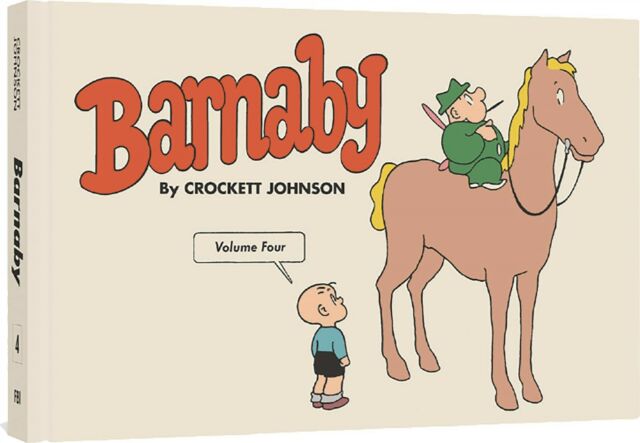
Crockett Johnson, Barnaby, Volume Four: 1948-1949. Co-edited by Philip Nel and Eric Reynolds. Foreword by Trina Robbins. Essays by Jared Gardner and Stephen Becker. Biographical Essay and Notes by Philip Nel. Design by Daniel Clowes. Seattle, WA: Fantagraphics Books, 2020.
- “Strikingly minimal was Barnaby, whose characters appeared in profile and whose talk balloons were lettered not by hand but by mechanical typesetting. In my love of cartoons, I sent away to [Johnson], begging for a free strip.”– John Updike
- “I wonder, is there a fairy godparents’ union? Has Mr. O’Malley failed so miserably as a fairy godfather in the past that Barnaby is his last chance, and if he fails this one he gets kicked out of the union? He’s lucky he got assigned to Barnaby, a boy with unwavering faith in his fairy godfather.”– Trina Robbins
- “No comic strip was more whimsically humorous than Crockett Johnson’s Barnaby.”– Time
- Read Chris Mautner’s “Talking ‘Barnaby’: An interview with co-editors Eric Reynolds and Phil Nel,” in Comic Book Resources (28 June 2014).
- Listen to “Crockett Johnson and Barnaby talk with Eric Reynolds and Philip Nel,” on InkStuds (May 2013). Note: The interview starts at 8 minutes in.
- Read “Interview: Philip Nel & Eric Reynolds on Crockett Johnson’s Barnaby from Fantagraphics,” at Westfield comics blog!
- Read my thoughts on publishing Barnaby Volume One, at Nine Kinds of Pie (my blog).
- Unboxing video!
- Learn more about Crockett Johnson:
- Read my “Crockett Johnson and the Invention of Barnaby“ in The Comics Journal (22 Apr. 2013).
- Read my “Before Barnaby: Crockett Johnson Grows Up and Turns Left” in The Comics Journal (26 Sept. 2012).
- Read my biographical essay on Crockett Johnson (pdf), which appeared in the now defunct Comic Art. In addition to being the most thorough biography of Johnson (prior to the publication of my full-length biography, listed below), the essay is fully illustrated (thanks to generous individuals and special collections).
- Visit my Crockett Johnson Homepage.
- Order the book from Fantagraphics.
- Order the book from Barnes and Noble.
- Order the book from Bookshop.org.
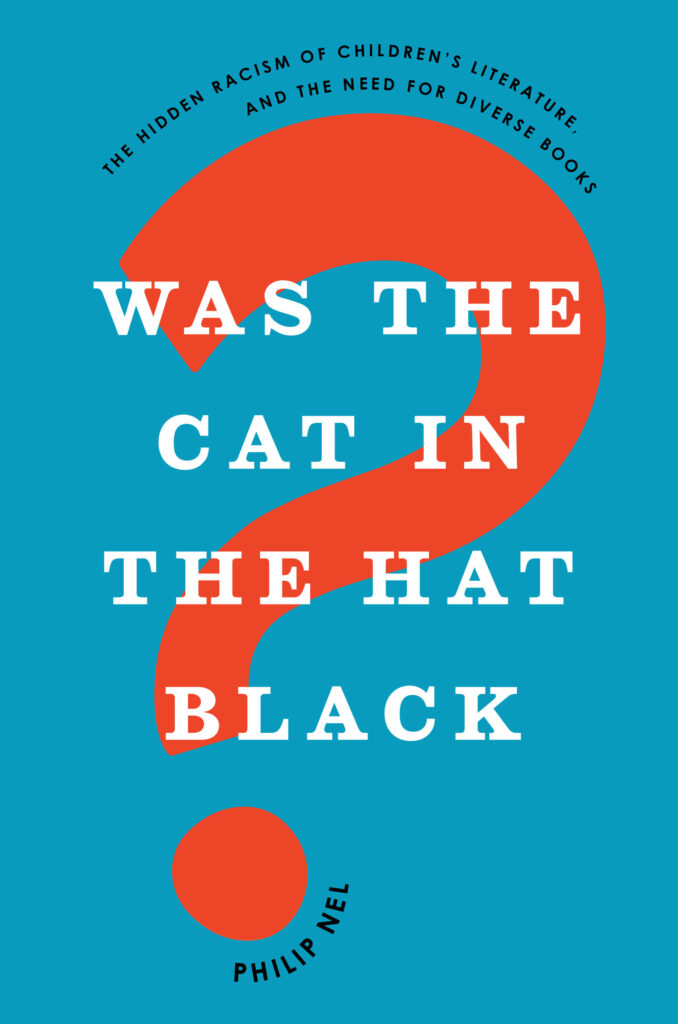
Philip Nel, Was the Cat in the Hat Black?: The Hidden Racism of Children’s Literature, and the Need for Diverse Books. Oxford University Press, 2017. 288 pages, 46 illustrations.
- Now available in paperback (2019) with a new afterword: “Why Adults Refuse to Admit Racist Content in the Children’s Books They Love.”
- Honorable Mention for the 2018 PROSE Award in Literature from the Association of American Publishers.
- A Choice Outstanding Academic Title of 2018.
- A Children’s Literature Association Honor Book of 2019.
- “In this powerful, deeply-researched, accessible study, Nel exposes the racial power of children’s literature. A rousing call to consciousness and action, Was the Cat in the Hat Black? shows how children’s literature [can] help build an anti-racist future. This book should be required reading for everyone–scholars, librarians, teachers, authors, readers, and more-who cares about children’s literature.” – Robin Bernstein
- “Philip Nel’s provocative book investigates the role of whiteness in creating conventions of children’s literature and speaks directly to the field’s profound omissions, defamations, and erasures. Not only does Nel excavate the hidden lineages and vexed investments of major authors like Theodor Geisel, but his argument demonstrates why this kind of interrogative work is fundamentally ethical and necessary to the field. A thoughtful, courageous book, Was the Cat in the Hat Black? links scholarship to activism, inspiring us to engage more fully race theory in our pedagogy, writing, and social practice.” – Katharine Capshaw
- “A state-of-the-art study of race and racism in U.S. children’s literature and an impassioned plea to debate its complexity, Was the Cat in the Hat Black? compellingly discerns the racial figurations hiding in plain sight. With theoretical acuity and prodigious learning, Nel shows that the answer to his title demands the cunning and high spirits of the children’s books themselves. Thing One and Thing Two, take note.” – Eric Lott
- “In this carefully constructed analysis, Nel brilliantly strips away the mask of innocence from Seuss’s Cat in the Hat, layer by layer, to reveal the Cat’s complex and sordid racial history. Placing this famous feline alongside other time-honored classic characters from American children’s literature, Nel removes ‘Whiteness’s invisibility cloak.’ He explodes the excuses that well-meaning scholars have made for these texts for decades, then makes a convincing argument for why young readers need to be exposed to unbowdlerized racist texts from historical and contemporary American literature. A straight, White male scholar, Nel advises: ‘Don’t just be an ally. Be an accomplice.’ As an African American female scholar, I am glad to have Nel alongside us on these front lines.” – Michelle Martin
- “In each chapter, the author demonstrates why he is considered a master in his field, as he faultlessly blends history and anecdote with insightful criticism…. A fascinating and necessary critical work.” — Kirkus Reviews
- “Like a detective working a literary crime scene, Nel patiently builds his case by piecing together clues and evidence in well-known stories from Dr. Seuss, and in the current young adult fiction renaissance. Nel uses such terms as invisible, covert, hidden, absence and erasure more than 70 times, by my count, to describe systemic racism’s clandestine modus operandi.”–John Murawski, News and Observer
- “If you are a parent or you work with young people in any capacity, this is perhaps the most important book you could read this year. In clear, methodical prose, Nel unmasks and makes explicit the overwhelming whiteness of beloved classics, suggests how we can balance our affection for our favorites while addressing their problematic elements, and lays the groundwork for how a more diverse world of children’s literature could be achieved. This is a brilliant and vital read.”– Stephanie Appell, Parnassus Books, Nashville, TN
- “The strength of Nel’s book is accessibility. Nel’s analysis is thought provoking and deep, and his tone and style open the discussion to a wide audience. Nel concludes with a ‘manifesto’ that lists actions all readers can easily accomplish, and this call to action adds to the book’s impact. Though the need for diversity in children’s books has been the subject of numerous articles and blogs, Nel’s book is the first detailed scholarly examination of this subject. Joining Suriyan Panlay’s Racism in Contemporary African American Children’s and Young Adult Literature (2016), which examines internalized racism in fiction by African American authors, Nel’s book is required reading. … Summing Up: Essential. Lower division undergraduates through faculty and professionals; general readers.” – P.J. Kurtz, Choice
- “this volume adds nuance and new layers to the current conversation on the need for diversity in children’s books. His conclusion, ‘A Manifesto for Anti-Racist Literature,’ provides actionable steps that producers and consumers of children’s literature–authors, scholars, parents, librarians, educators, and publishing professionals–can take to dismantle the white supremacy inherent in the industry…. A necessary purchase for academic and professional reading collections.” – Shelley M. Diaz, School Library Journal, Feb. 2018
- Media:
- Philip Nel, “Was the Cat in the Hat Black?: The Hidden Racism of Children’s Literature and the Need for Diverse Books,” Talks at Google, 25 Sept. 2017. (Recorded 17 July 2017)
- Sarah Begley’s “The Hidden (and Not-So Hidden) Racism in Kids’ Lit,” in Time magazine (print issue of 7 Aug. 2017), features the book.
- Interviews:
- Leonard Cassuto, “How to Go Public, and Why We Must.” The Chronicle of Higher Education, 7 Jan. 2018
- Valerie Strauss, “Just How Racist Is Children’s Literature? The author of ‘Was the Cat in the Hat Black?’ explains,” Washington Post, 11 Dec. 2017
- Darcel Rockett, “Author: Racism Revealed in Seuss’s work, children’s literature,” Chicago Tribune, 27 Nov. 2017.
- Mike Pesca, “Putting Dr. Seuss on the Couch,” The Gist (Slate), 31 Oct. 2017. 26-minute podcast.
- Kate Townshend, “TES talks to… Philip Nel,” TES, 29 Sept. 2017.
- Gina Kaufmann & Matthew Long-Middleton, “Hidden Racism in Children’s Literature,” Central Standard, KCUR, 22 Aug. 2017.
- Isabel Fattal, “Reading Racism in Dr. Seuss,” in The Atlantic, 15 Aug. 2017.
- Oxford UP:
- Philip Nel, “7 questions we should ask about children’s literature,” Oxford University Press Blog, 19 Sept. 2017
- Philip Nel, “What do children’s books tell us about society?” Oxford University Press. 90-second video.
- More videos at Oxford UP: click on “Author Interview” in left menu.
- L’affaire Melania et Chat:
- Liz Phipps Soeiro, “Dear Mrs. Trump,” The Horn Book 26 Sept. 2017
- Rachel Chason, “‘Racist propaganda’: Librarian rejects Melania Trump’s gift of Dr. Seuss books,” Washington Post 28 Sept. 2017
- Maria Puente, “The debate over Dr. Seuss: When racist themes collides with childhood nostalgia,” USA Today 29 Sept. 2017
- Tim Marcin, “Was Dr. Seuss Racist? Old Cartoons Support a Librarian’s Claims Made While Denying Melania’s Book Donation,” Newsweek 30 Sept. 2017.
- Cover, table of contents, and related blog posts (on my blog).
- Order the book from Barnes and Noble.
- Order the book from Powell’s City of Books.
- Order the book from Oxford University Press.
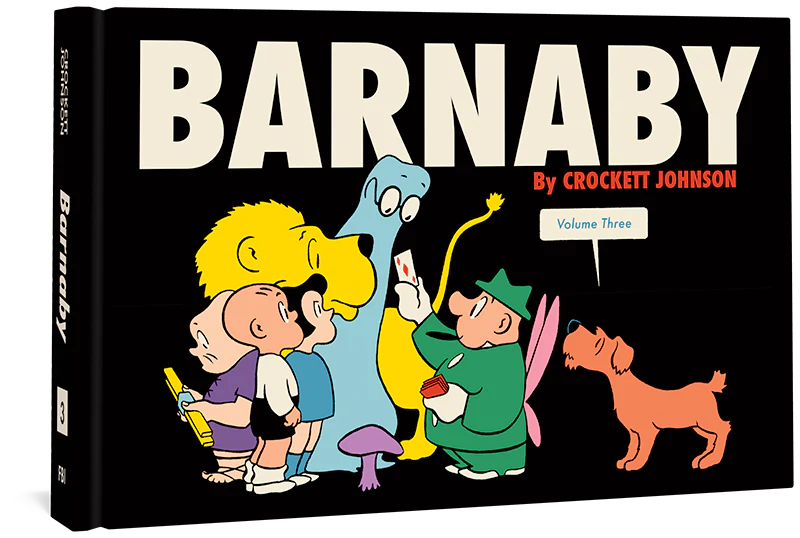
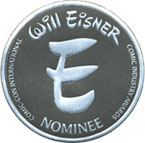 Crockett Johnson, Barnaby, Volume Three: 1946-1947. Co-edited by Philip Nel and Eric Reynolds. Foreword by Jeff Smith. Essays by Nathalie op de Beeck and Coulton Waugh. Biographical Essay and Notes by Philip Nel. Design by Daniel Clowes. Seattle, WA: Fantagraphics Books, 2016. 371 pp.
Crockett Johnson, Barnaby, Volume Three: 1946-1947. Co-edited by Philip Nel and Eric Reynolds. Foreword by Jeff Smith. Essays by Nathalie op de Beeck and Coulton Waugh. Biographical Essay and Notes by Philip Nel. Design by Daniel Clowes. Seattle, WA: Fantagraphics Books, 2016. 371 pp.
- Nominated for a 2017 Eisner Award, in the “Best Archival Collection/Project – Strips” category.
- “Barnaby by Crockett Johnson is a gentle, intelligent, funny, and ridiculous masterpiece”– Jeff Smith
- “Crockett Johnson is best known today for his children’s books…but his paramount creation was the celebrated if obscure newspaper strip Barnaby…. This effort is the first to collect it in its entirety. Even Mr. O’Malley couldn’t conjure up a more welcome endeavor.”– Booklist
- “the strip is hilarious, with a satirical bent (one of O’Malley’s preposterous exploits gets him elected to Congress in absentia) and erudite, literate humor, exemplified by O’Malley’s far-out-of-date cultural references (helpfully explained here in endnotes). The winningly absurd supporting cast includes Atlas the pygmy giant, talking dog Gorgon, and Gus the timid ghost.”– School Library Journal
- Read Chris Mautner’s “Talking ‘Barnaby’: An interview with co-editors Eric Reynolds and Phil Nel,” in Comic Book Resources (28 June 2014).
- Listen to “Crockett Johnson and Barnaby talk with Eric Reynolds and Philip Nel,” on InkStuds (May 2013). Note: The interview starts at 8 minutes in.
- Read “Interview: Philip Nel & Eric Reynolds on Crockett Johnson’s Barnaby from Fantagraphics,” at Westfield comics blog!
- Read my thoughts on publishing Barnaby Volume One, at Nine Kinds of Pie (my blog).
- Learn more about Crockett Johnson:
- Read my “Crockett Johnson and the Invention of Barnaby“ in The Comics Journal (22 Apr. 2013).
- Read my “Before Barnaby: Crockett Johnson Grows Up and Turns Left” in The Comics Journal (26 Sept. 2012).
- Read my biographical essay on Crockett Johnson (pdf), which appeared in the now defunct Comic Art. In addition to being the most thorough biography of Johnson (prior to the publication of my full-length biography, listed below), the essay is fully illustrated (thanks to generous individuals and special collections).
- Visit my Crockett Johnson Homepage.
- Order the book from Fantagraphics.
- Order the book from Barnes and Noble.
- Order the book from Powell’s City of Books.
- Order the book from Rainy Day Books.
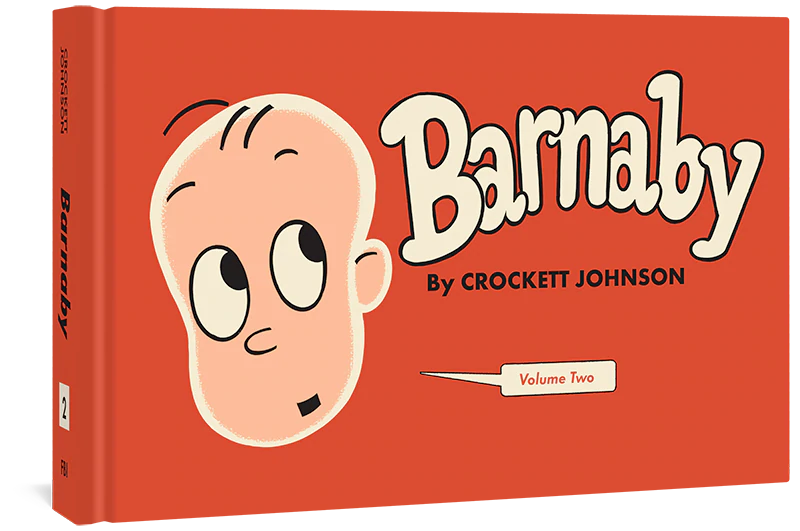
Crockett Johnson, Barnaby, Volume Two: 1944-1945. Co-edited by Philip Nel and Eric Reynolds. Foreword by Jules Feiffer. Essays by R.C. Harvey and Max Lerner. Biographical Essay and Notes by Philip Nel. Design by Daniel Clowes. Seattle, WA: Fantagraphics Books, 2014. 375 pp.
- “Barnaby’s typeset balloons fuse Crockett Johnson’s precisely composed text and drawings into extensions of each other – Comics as Graphic Design! To replace hand-lettering with Futura, a font that strips away the non-essential to insist on clarity, might seem like an odd choice for a strip that radiates human warmth and whimsy – but it allows the artist’s brilliantly-written characters to keep their feet planted in the all-too-real world of 1940s America while flying off on pink wings into one of the greatest fantasy strips ever made.”– Art Spiegelman
- “Barnaby … belongs to a tradition of strips, from Pogo toBloom County, that mix kid-friendly fantasy with adult satire…. [Crockett Johnson] gave us one of the 20th century’s most entertaining comic-strip characters, J.J. O’Malley. He might not be the fairy godmother a boy wants, but he’s the egotistical lowlife of a fairy godfather we all deserve.”– Jesse Walker, “Our Fairy Godfather,” Reason, Jan. 2015
- “That’s the unalloyed brilliance of Johnson’s strip: in the end there’s nothing extraordinary in this world: only little flying men, ghosts and imps of all sorts, talking dogs, and the like, and a well-balanced little boy who doesn’t consider that anyone should think any of this to be unexpected. …. These are gorgeous and charming books, fine harbingers of future volumes in the series, and a necessary reminder of the gentle pleasures of, as Ware observes, the last great uncollected comic strip.”– Terry Harpold, “Gosh!”, ImageText 7.3 (Oct. 2014)
- “Five-year-old Barnaby Baxter and his fairy godfather, Mr. O’Malley, had amazing journeys through the world (and dark underbelly) of politics, high finance and current events. They crossed the line between reality and imagination as often as we crossed the street, leaving readers spellbound and craving more.”– Michael Taube, The Washington Times, 22 July 2014
- Visit Fantagraphics’ page, for photos, a video, and a pdf (excerpt).
- Read Chris Mautner’s “Talking ‘Barnaby’: An interview with co-editors Eric Reynolds and Phil Nel,” in Comic Book Resources (28 June 2014).
- Read my “Crockett Johnson’s Elusive Allusions: Errata for Barnaby Volume Two,” on Nine Kinds of Pie (23 June 2014).
- Listen to “Crockett Johnson and Barnaby talk with Eric Reynolds and Philip Nel,” on InkStuds (May 2013). Note: The interview starts at 8 minutes in.
- Read “Interview: Philip Nel & Eric Reynolds on Crockett Johnson’s Barnaby from Fantagraphics,” at Westfield comics blog!
- Read my thoughts on publishing Barnaby Volume One, at Nine Kinds of Pie (my blog).
- Learn more about Crockett Johnson:
- Read my “Crockett Johnson and the Invention of Barnaby“ in The Comics Journal (22 Apr. 2013).
- Read my “Before Barnaby: Crockett Johnson Grows Up and Turns Left” in The Comics Journal (26 Sept. 2012).
- Read my biographical essay on Crockett Johnson (pdf), which appeared in the now defunct Comic Art. In addition to being the most thorough biography of Johnson (prior to the publication of my full-length biography, listed below), the essay is fully illustrated (thanks to generous individuals and special collections).
- Visit my Crockett Johnson Homepage.
- Order the book from Fantagraphics.
- Order the book from Barnes and Noble.
- Order the book from Powell’s City of Books.
- Order the book from Rainy Day Books.
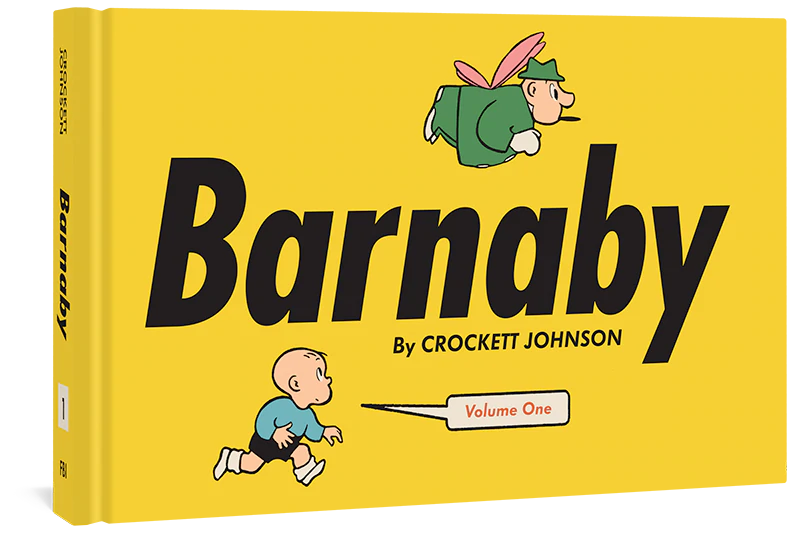
 Crockett Johnson, Barnaby, Volume One: 1942-1943. Co-edited by Philip Nel and Eric Reynolds. Foreword by Chris Ware. Essays by Jeet Heer and Dorothy Parker. Biographical Essay and Notes by Philip Nel. Design by Daniel Clowes. Seattle, WA: Fantagraphics Books, 2013. 319 pp.
Crockett Johnson, Barnaby, Volume One: 1942-1943. Co-edited by Philip Nel and Eric Reynolds. Foreword by Chris Ware. Essays by Jeet Heer and Dorothy Parker. Biographical Essay and Notes by Philip Nel. Design by Daniel Clowes. Seattle, WA: Fantagraphics Books, 2013. 319 pp.
- Nominated for a 2014 Eisner Award, in the “Best Archival Collection/Project – Strips” category.
- “I think, and I am trying to talk calmy, that Barnaby and his friends and oppressors are the most important additions to American arts and letters in lord knows how many years. I know that they are the most important additions to my heart. . . . I think Mr. Johnson must love people. I know darned well I must love Mr. Johnson”– Dorothy Parker
- “I never thought I’d see this day, but the book you hold is, well… the last great comic strip. Yes, there are dozens of other strips worth rereading, but none are this Great; this is great like Beethoven, or Steinbeck, or Picasso. This is so great it lives in its own timeless bubble of oddness and truth.”– Chris Ware
- “There’s no way Jack Kerouac, along with every other self-consciously cool person in New York, wasn’t reading this. O’Malley turns into Neal Cassady, the guy who’s note quite human, who never shuts up, who drives you crazy, and who can make anything happen, just like that. There will be a Volume Two; in the meantime, there’s also Nel’s lively, inspiring Crockett Johnson and Ruth Krauss: How an Unlikely Couple Found Love, Dodged the FBI, and Transformed Children’s Literature“– Greil Marcus, The Believer, Nov.-Dec 2013
- “Crockett Johnson’s Barnaby [is] one of the finest and most thought-provoking comic strips ever created…. As expected, this book meets Fantagraphics’s usual high standards for bringing the pen-and-ink classic comics back to life. A bright yellow cover with a World War II-inspired design, combined with informative essays and a glossary of the historic events covered in the strips, makes this book a real treasure for readers of all ages. … [T]here has always been a subtle charm about Barnaby, Mr. O’Malley, and supporting characters such as Gus the Ghost and Gorgon the dog, that completely transcends political lines. Liberals may love Barnaby, but there is no reason why conservatives and libertarians can’t admire the beauty, simplicity, wittiness and intelligence of this groundbreaking strip, too.”– Michael Taube, The Washington Times, 26 July 2013
- “One of the great, hard-to-find, classic comic strips”– Rich Barrett, Mental Floss, 19 June 2013
- “Though Harold is considered the classic, Barnaby received lots of critical acclaim in its day. One look at it and you’ll see why…. Though the stories revolve around five year old Barnaby and his fairy godfather (along with a ghost, lion, and more), the seemingly whimsical strip dealt with important issues in a way that didn’t talk down to children. Thus it’s one of those great strips that provided entertainment for young readers and their parents.”– Seth Peagler, The Heroes On-Line Blog, 19 June 2013
- Listen to “Crockett Johnson and Barnaby talk with Eric Reynolds and Philip Nel,” on InkStuds (May 2013). Note: The interview starts at 8 minutes in.
- Read “Crockett Johnson’s BARNABY: 1st Look,” at Fantagraphics’ blog. Eric Reynolds offers a preview, with original sketches from Daniel Clowes.
- Read “Interview: Philip Nel & Eric Reynolds on Crockett Johnson’s Barnaby from Fantagraphics,” at Westfield comics blog!
- Read my thoughts on publishing Barnaby Volume One, at Nine Kinds of Pie (my blog).
- Learn more about Crockett Johnson:
- Read my “Crockett Johnson and the Invention of Barnaby“ in The Comics Journal (22 Apr. 2013).
- Read my “Before Barnaby: Crockett Johnson Grows Up and Turns Left” in The Comics Journal (26 Sept. 2012).
- Read my biographical essay on Crockett Johnson (pdf), which appeared in the now defunct Comic Art. In addition to being the most thorough biography of Johnson (prior to the publication of my full-length biography, listed below), the essay is fully illustrated (thanks to generous individuals and special collections).
- Visit my Crockett Johnson Homepage.
- Order the book from Fantagraphics.
- Order the book from Barnes and Noble.
- Order the book from Powell’s City of Books.
- Order the book from Rainy Day Books.
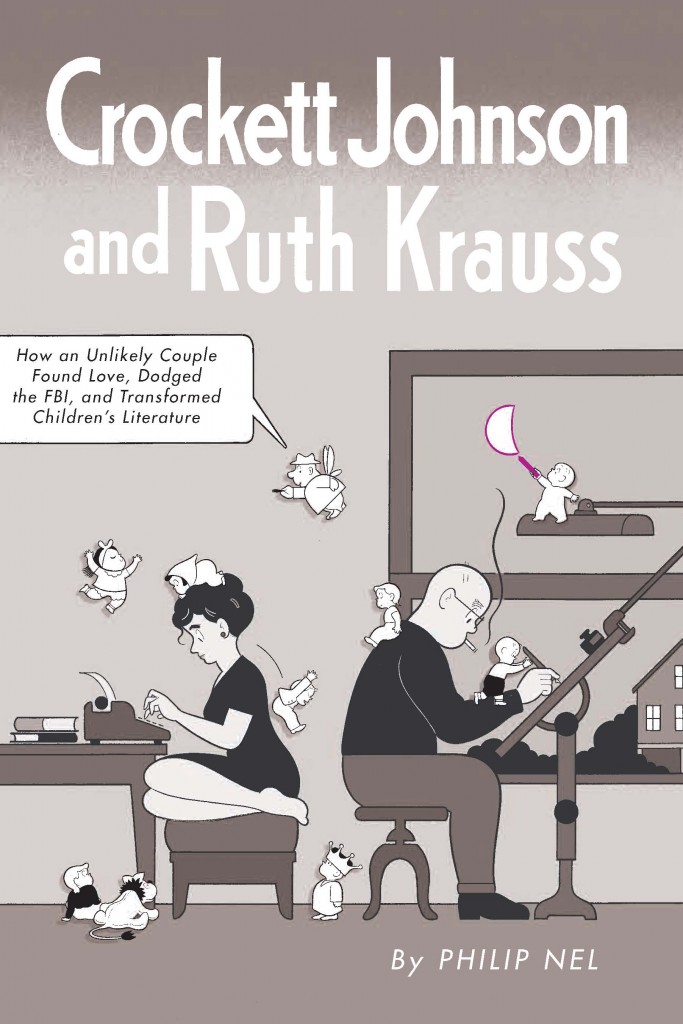
 Philip Nel, Crockett Johnson and Ruth Krauss: How an Unlikely Couple Found Love, Dodged the FBI, and Transformed Children’s Literature. University Press of Mississippi, 2012. 368 pages, 88 illustrations. Cover by Chris Ware.
Philip Nel, Crockett Johnson and Ruth Krauss: How an Unlikely Couple Found Love, Dodged the FBI, and Transformed Children’s Literature. University Press of Mississippi, 2012. 368 pages, 88 illustrations. Cover by Chris Ware.
- Nominated for a 2013 Eisner Award, in the “Best Educational/Academic Work” category.
- Named a Children’s Literature Association Honor Book, 2014.
- Winner of Southwest Popular/American Culture Association’s Rollins Book Award, 2014.
- “Krauss and Johnson have influenced as many contemporary children’s book creators as Maurice Sendak or Chris Van Allsburg, yet biographical material on either or both was as rare as a giant carrot. Now author Phil Nel has remedied this with his insightful, thorough and thoroughly enjoyable book.”– Lane Smith
- “Mr. Nel’s engrossing, beautifully-researched dual-biography of these two mid-century masters and their enviable symbiosis will restore the cynic’s faith in love and marriage and elicit gasps of shock from devotees of the genre at the sheer decency of their lives.”– Daniel Clowes
- “a perceptive account of the couple’s domestic, artistic, and political lives. While foregrounding the creation of such classics as Johnson’s Harold and the Purple Crayon and Krauss’s (and Sendak’s) A Hole Is to Dig, Nel places these within the brimming context of two artistic lives that included studio painting (for Johnson) and poetry and plays (for Krauss). His accessible analysis of their work and its importance is partnered by an engaging portrait of their lives; readers will understand why the young Sendak found their company so inviting and inspirational.”
- “wonderful new dual biography…. This book is a great read…. Highly recommended!” — James Sturm, Center for Cartoon Studies
- “Nel has a gift for stitching together his exhaustive research into a brisk, highly readable narrative.” — Jack Feerick, Kirkus Reviews
- “an invaluable resource for those who love children’s books.”– Anita Silvey, Children’s Book-a-Day Almanac, 25 Sept. 2012
- “Krauss and Johnson loomed larger in the last century than they do now, but Mr. Nel argues that it would be a mistake to miss the durability of their legacy. The petite and turbulent Krauss, who wrote more than 40 works for young readers, ‘helped pave the way for books that respect children’s tough, pragmatic thinking and unorthodox use of language,’ he says. Of the wry and laconic Johnson, whose work is often cited by artistic sorts as a source of inspiration, the author declares: ‘He showed us that a crayon can create a world.'”– Meghan Cox Gurdon, “A Dramatic Duo in Purple and Pink,” The Wall Street Journal, 5 Oct. 2012
- “Philip Nel’s new book wins the award, hands down, for best title of the year…. But more than that it gives us a narrative that hisses and crackles with energy, even with two subjects whose lives lacked the kind of intrigue and mystery that ordinarily makes for exciting biographical research and writing.”– Maria Tatar, “Philip Nel’s Radical New Book,” Breezes from Wonderland, 4 Nov. 2012
- “Philip Nel’s scrupulously researched and beautifully written literary biography, Crockett Johnson and Ruth Krauss: How an Unlikely Couple Found Love, Dodged the FBI, and Transformed Children’s Literature succeeds in rendering its two subjects in the detailed and unflinching manner that Forster demands of the novelist. … To cite Forster once again, Nel’s biography offers us not only round characters, but a pair of colorful and mutually devoted intellectuals whom we might wish to know just as well as our ‘fellow creatures’ — including our own colleagues.”– Anastasia Ulanowicz, Lion and the Unicorn 37.3 (Sept. 2013)
- “Nel’s gorgeous and rallying Crockett Johnson and Ruth Krauss: How an Unlikely Couple Found Love, Dodged the FBI, and Transformed Children’s Literature. I love those two so much I wish I still used Trapper Keepers so I could glue their faces onto one. They wrote all kinds of stories, together and separately, for both adults and children, all their lives, and as someone who wants this too I learn from how Nel maps their homes, remembers their arguments, and talks about how they talked about money and the government.”– Mairead Case, Bookslut, May 2015
- I’ve posted Chris Ware’s full, wraparound cover on my blog. Click, and then zoom in to see all of the details.
- Visit my Crockett Johnson Homepage.
- Read my biographical essay on Crockett Johnson (pdf), which appeared in the now defunct Comic Art. In addition to being the most thorough biography of Johnson (prior to the publication of this book), the essay is fully illustrated (thanks to generous individuals and special collections).
- Read “Before Barnaby: Crockett Johnson Grows Up and Turns Left,” adapted from the bio. and appearing in The Comics Journal in September 2012.
- Learn more about the biography and other projects on Nine Kinds of Pie (my blog).
- Order the book from Barnes and Noble.
- Order the book from Powell’s City of Books.
- Order the book from Rainy Day Books.
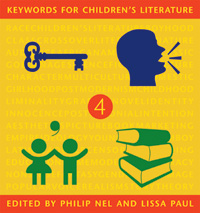
Philip Nel and Lissa Paul, editors, Keywords for Children’s Literature. New York University Press, 2011. 282 pages.
- “Keywords for Children’s Literature demonstrates how sophisticated the critical approaches to the burgeoning field of children’s literature have become. Not only do the essays on keywords, written by some of the most capable professors in the field, elaborate important concepts in the history of children’s literature, but they cover significant cultural debates and discussions. This superb volume of scholarship demonstrates–definitively–that adult literature cannot be understood without grasping its roots in children’s literature.”– Jack Zipes
- “By distilling the complex uses of its core terms, the contributors to Keywords for Children’s Literature have produced an indispensable handbook for scholars in this dynamic field.”– Donald E. Pease
- “This book presents … thoughtful essays based on various concepts pertaining to children’s literature, including genres, literary theories, and the history of children’s literature … This volume will be very useful, especially for colleges and universities with children’s literature programs. Highly recommended.” — J. Stevens, Choice
- “Overall, this volume succeeds quite well in focusing attention on how we discuss children’s literature. The[se] essays are models of thoughtful inquiry into words we frequently use, often without considering how they have been transformed over time” — Myra Zarnowski, Teachers College Record
- “an indispensable title in any children’s literature scholar’s library…. This book is a monumental achievement.”– Claudia Mills, Children’s Literature Association Quarterly 37.1 (Spring 2012), pp. 110, 112.
- Order the book from Barnes and Noble
- Order the book from Powell’s City of Books
- Order the book from Rainy Day Books
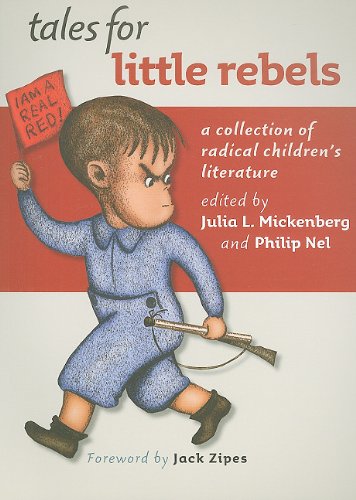
Julia Mickenberg and Philip Nel, editors, Tales for Little Rebels: A Collection of Radical Children’s Literature. Foreword by Jack Zipes. New York University Press, 2008. 295 pages, 100 illustrations.
- “As Julia L. Mickenberg and Philip Nel document in Tales for Little Rebels: A Collection of Radical Children’s Literature (New York University, $32.95), Marxist principles have been dripping steadily into the minds of American youth for more than a century. This isn’t altogether surprising. After all, most parents want their children to be far left in their early years — to share toys, to eschew the torture of siblings, to leave a clean environment behind them, to refrain from causing the extinction of the dog, to rise above coveting and hoarding, and to view the blandishments of corporate America through a lens of harsh skepticism. But fewer parents wish for their children to carry all these virtues into adulthood. It is one thing to convince your child that no individual owns the sandbox […]. It is another to hope that when he grows up he will donate the family home to a workers’ collective. […] And in the next few years, as America backs cautiously away from its laissez-faire disasters and reluctantly into an unfamiliar, communal style of politics, some of us may find ourselves wishing we had been scared with such rhymes in kindergarten instead of having to live through them as adults.”– Caleb Crain, “Children of the Left, Unite!”, New York Times Book Review, 11 Jan. 2009, p. 23.
- “By introducing kids (and their parents) to a wide range of forgotten and overlooked texts addressing progressive themes, and by provoking a closer look at what the books we already own imply, Mickenberg and Nel have done parents and kids alike a truly important service.”– Jenny Browne, “Progressive Primers,” Texas Observer, 9 Jan. 2009.
- “Tales for Little Rebels (NYU) anthologizes 75 years of radical children’s literature. It’s a rousing, relevant chronicle of teaching kids about social and environmental justice, civil rights, and their power to challenge the status quo.”– Julie Hanus, Utne Reader, Jan-Feb. 2009.
- “the book reveals a unique, vibrant, imaginative, and energetic left-wing tradition of writing for young people. It is an invaluable resource for progressive educators and hopefully will inspire teachers to write and even publish their own children’s books dealing with sensitive political and social issues.”– Herb Kohl, “Good Stuff: Little Rebels,” Rethinking Schools Online, Winter 2008/2009.
- “Tales for Little Rebels is a remarkable book in many ways […]. According to liberal and conservative critics alike, radical, socialist, and communist teachings, indeed any kind of pedagogy condemning capitalism as a social system and envisioning something more cooperative, can only be dreadful stuff. This collection gives the lie to that. The prose excerpts are fascinating; the illustrations are perfectly fabulous and, very often, really funny. […] The editors, Philip Nel (our best scholar of Geisel) and Julia Mickenberg (authoritative expert on progressive children’s books of the 1950s-70s) offer outstanding annotations and introductions; fairy tale scholar Jack Zipes adds a fascinating Foreword.”– Paul Buhle, Monthly Review Webzine, 13 Dec. 2008.
- “Some weave the messages deftly into their stories and others subordinate the entertainment to a lesson so blunt you could pound yams with it, but the mixture is consistently fascinating. It helps that the tales, illustrated by the likes of Walter Crane, Boris Artzybasheff and Lynd Ward and prefaced by the editors’ thorough and helpful introductions, boast authors as skilled as Carl Sandburg, Munro (Ferdinand the Bull) Leaf, Dr. Seuss, Eve Merriam and Langston Hughes.”– Warren Clements, “Kids, capitalists, and commies,” Globe and Mail, 22 Nov. 2008.
- “Some of the selections are funny, such as Jerome Lawrence Schwartz’s story about an ostrich named Oscar, who gets his warm sand dune (good for head-poking) usurped by a loud-voiced fascist ostrich; others are alarming in their didactic shrillness”– Andrea Walker, “The Book Bench,” New Yorker, 14 Nov. 2008.
- “a collection, with commentary, that blends old left, new left, hard left, soft left, and -isms from communism and socialism to feminism, environmentalism, and antiracism. The mosaic is the message. There was ‘never a unified voice of the Left,’ they write, ‘just as there was never a unified vision of the child.'”– Nina C. Ayoub, “Nota Bene: Little Rebels; Watching the Watchers,” Chronicle of Higher Education, 7 Nov. 2008.
- “Mickenberg and Nel remind us how politically radical some of the most-beloved children’s books are”– Rachel Hartigan Shea, “Better Read Than Red,” Washington Post, 4 Nov. 2008.

- C-SPAN2’s Book TV: Julia Mickenberg, Philip Nel, and Charlotte Pomerantz (author of The Day They Parachuted Cats on Borneo) talk about and read from Tales for Little Rebels at Bluestockings Bookstore, New York, 20 Dec. 2008. First aired 31 Jan. and 1 Feb. 2009.
- Read New York University Press’ page.
- Read “Getting a Taste for Some Tales for Little Rebels,” Elizabeth Bird’s account of the book party at NYU’s Bobst Library, 18 Dec. 2008.
- Order the book from Barnes and Noble.
- Order the book from Powell’s City of Books.
- Order the book from Rainy Day Books.
- English 680: Radical Children’s Literature (Fall 2008). A course taught by Philip Nel.
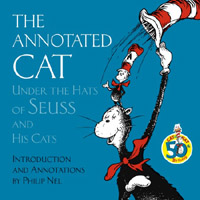
Philip Nel, The Annotated Cat: Under the Hats of Seuss and His Cats. Random House, 2007.
- “a super-dooper-doozidy-floozer of a doozy. […] The Cat in the Hat […] changed kid’s books forever and now Mr. Nel has edited The Annotated Cat: Under the Hats of Seuss and His Cats. For Seuss fanatics like myself it’s as sweet as pink cake (with little cross-hatch lines on the sides).” — Lane Smith
- “In The Annotated Cat: Under the Hats of Seuss and His Cats, Philip Nel gives us a better grip on just why Dr. Seuss has so thoroughly captured the imaginations of several generations of readers–and the imaginations of their parents. […] Nel’s line-by-line annotations illuminate precisely how Seuss created his masterwork […]. Showing us how Seuss worked–showing him assemble the cat line by line in ink and print–is the coolest gift this Annotated Cat could give us.” — Malcolm Jones, Newsweek
- “Philip Nel has researched and assembled a scrapbook of fascinating historical tidbits.” — The Poetry Foundation, which named The Annotated Cat a “Book Pick”
- “A must-read for the Seuss lover or hopeful children’s writer.” — Jamie Driggers, Armchair Interviews
- “Nel does a terrific job of supplying the backstory behind both the book and the man and explaining why and how Cat became a worldwide favorite.” — Booklist
- “Nel’s crowning achievement is that he keeps everything fun, not fusty or snooty. […] The best fun in the book is watching Dr. Seuss at work through first drafts and rough coloured-pencil sketches.” — Bruce Ward, The Ottawa Citizen
- “Nel proves that it is fun to take Seuss’s work seriously. […] The well-documented text includes original manuscripts, early sketches, and illustrations with detailed analysis and descriptions. This text is an excellent addition to any school or public library and is essential reading for all who work with youth, literacy, and literature.” — Rebecca Sheridan, School Library Journal
- See a larger image of the cover.
- Read Random House’s page.
- Order the book from Barnes and Noble.
- Order the book from Powell’s City of Books.
- Order the book from Rainy Day Books.
- Dr. Seuss on the Web: A collection of links assembled by Philip Nel.
- English 710: Dr. Seuss (Spring 2012): A course taught by Philip Nel
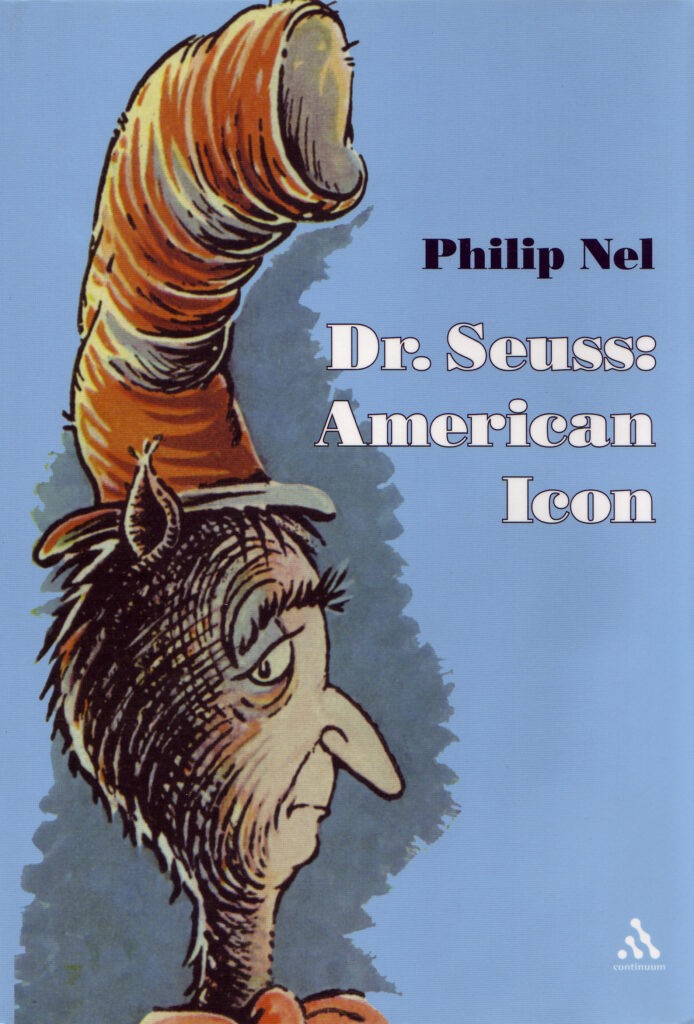
Philip Nel, Dr. Seuss: American Icon. New York and London: Continuum Publishing, 2004. 320 pages, 33 illustrations.
- A Choice Magazine “Outstanding Academic Book of 2004”
- “even nonacademics will come away enlightened about the talented man who wanted to wake people up to events in the world and leave a moral legacy for children.” — Booklist
- “definitive […] comprehensive […] will tell grown-ups more than they ever wanted to know about Dr. Seuss.” — The Economist
- “Mr. Nel has done his homework […] he draws on a wealth of esoteric knowledge” — The New York Sun
- See a larger image of the cover.
- Read Continuum Publishing’s page.
- Buy the book via NPR: a portion of your purchase will benefit National Public Radio.
- Buy the book from Barnes and Noble.
- Buy the book from Powell’s City of Books.
- Buy the book from Rainy Day Books.
- Dr. Seuss on the Web: A collection of links assembled by Philip Nel
- English 710: Dr. Seuss (Spring 2012): A course taught by Philip Nel
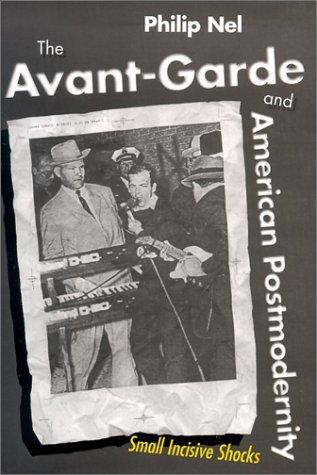
Philip Nel, The Avant-Garde and American Postmodernity: Small Incisive Shocks. Jackson and London: University Press of Mississippi, 2002. 249 pages, 41 illustrations.
- “Nel is […] equally at home in popular and university circles. […] Happily, Nel exhibits these combined merits in user-friendly prose. The Avant-Garde and American Postmodernity is a provocative and appealing book.” — Arthur Saltzman, symploké
- “a very good account of the avant-garde’s shaping influence in American life and letters, one that raises many valuable questions.” — Kenneth Kidd, Children’s Literature
- “By stressing the stylistic continuities between modernism and postmodernism, Nel […] not only undermines any reified notions of periodicity but reminds us that modernism, in its specifically avant-garde formulations, is still very much with us. That the homogeneity of our postmodern simulacrum is challenged by The Cat in the Hat and Two Bad Ants as well as Snow White or Underworld is good news indeed.” — Norman Finkelstein, American Literature
- “Philip Nel’s writing is a pleasure: lively clear, stylish, and free of unnecessary jargon. […] The Avant-Garde and American Postmodernity: Small Incisive Shocks is a joy to read, raising, in true postmodernist fashion, as many questions as it answers.” — Richard Flynn, The Children’s Literature Association Quarterly
- See a larger image of the cover.
- Read the University Press of Mississippi’s page.
- Buy the book from Barnes and Noble.
- Buy the book from Powell’s City of Books.
- Buy the book from Rainy Day Books.
- Read “‘A small incisive shock’: Modern Forms, Postmodern Politics, and the Role of the Avant-Garde in Don DeLillo’s Underworld,” which (in a revised form) appears as a chapter in this book.
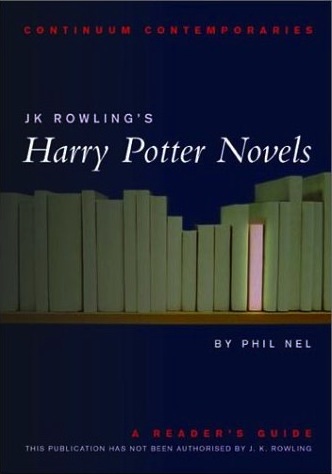
Philip Nel, J. K. Rowling’s Harry Potter Novels: A Reader’s Guide. New York and London: Continuum Publishing, 2001. 96 pages. Also available in Japanese translation by Ihei Taniguchi, published by Jiritsu-shobo Inc., 2002.
- “the single best piece of literary criticism on the Potter series […] Philip Nel is the best thing to happen so far to Harry Potter in the American classroom.” — Jim Trelease, author of The Read-Aloud Handbook.
- “packs the most bang for your buck of all the about-Potter books.” — Lana Whited, The Lion and the Unicorn
- Buy the book from Amazon.co.uk.
- Buy the book from Barnes and Noble.
- Buy the book from Powell’s.
- Buy the book from St. Mark’s Bookshop.
- Buy the Japanese translation book from Amazon.co.jp.
- Read Continuum Publishing’s page.
- Read Deirdre Donahue’s “‘Potter’ inspires academic analysis,” USA Today, 16 Nov. 2001, p. E3.
- Read Jim Trelease’s review (scroll down to “Educators’ Guide to Potter Series”)
- Read other articles.
- J. K. Rowling on the Web: A collection of links assembled by Philip Nel
Afterwords/Forewords/Introductions
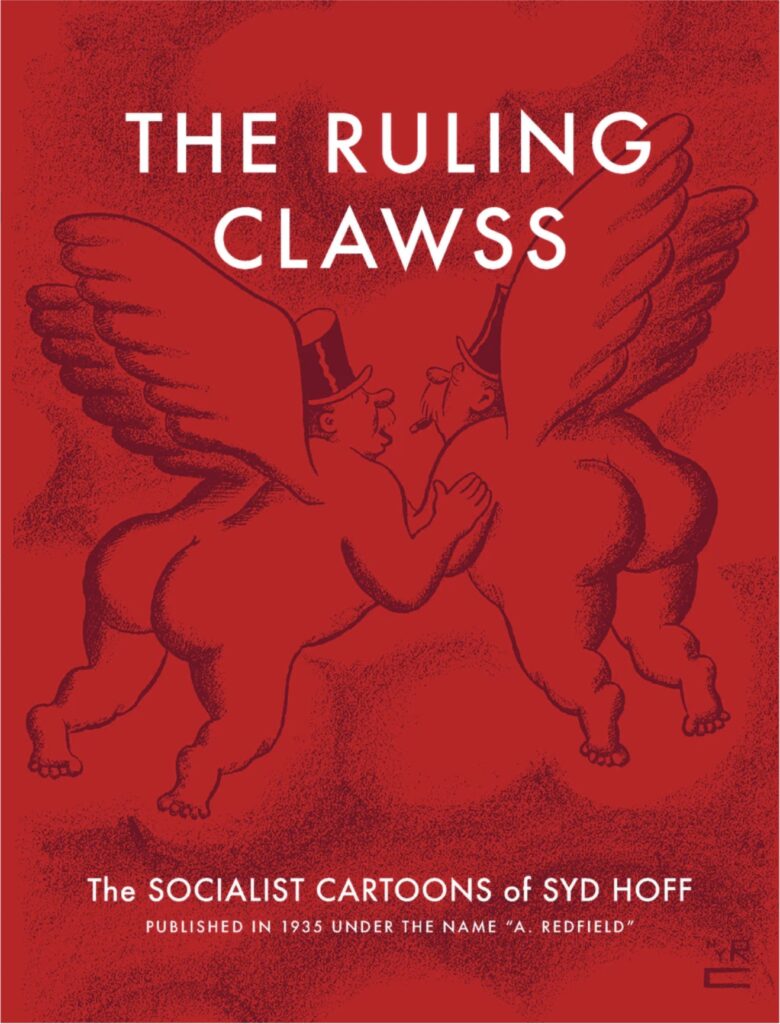
Syd Hoff, The Ruling Clawss. Introduction by Philip Nel. New York: New York Review Books, 2023.
- More on the book at New York Review Books.
- My unboxing video and a bit more about the book (on my blog).
- “The work [Syd Hoff] produced hardly feels its ninety years. If it weren’t for the attire in which Hoff’s oafish representatives of the ruling class are outfitted — tuxedos aplenty, modest gowns for the women — and his propensity for drawing the rich as almost uniformly overweight, the illustrations could be of the modern-day United States. After all, our era has much in common with that of “A. Redfield’s”: eye-popping inequality, rampant homelessness and police brutality, racism, and the many pompous, moronic captains of industry.” — Alex N. Press, Jacobin
- “a fascinating look into the issues of the 1930s through the lens of a communist cartoonist. And they certainly resonate in today’s political and economic environment.” — Ruben Bolling, Boing Boing
- “the sort of book you wish weren’t still so relevant nearly a century after its first publication. A must for Syd Hoff fans and collectors of political cartoons alike.” — Tom Bowden, The Book Beat
- Buy the book from Bookshop.org.
- Buy the book from Left Bank Books.
- Buy the book from Moon Palace Books.
- Buy the book from Powell’s City of Books.
- Buy the book from Rainy Day Books.
- You can also buy the book from the usual suspects. But, instead, why not support local and independent bookstores?
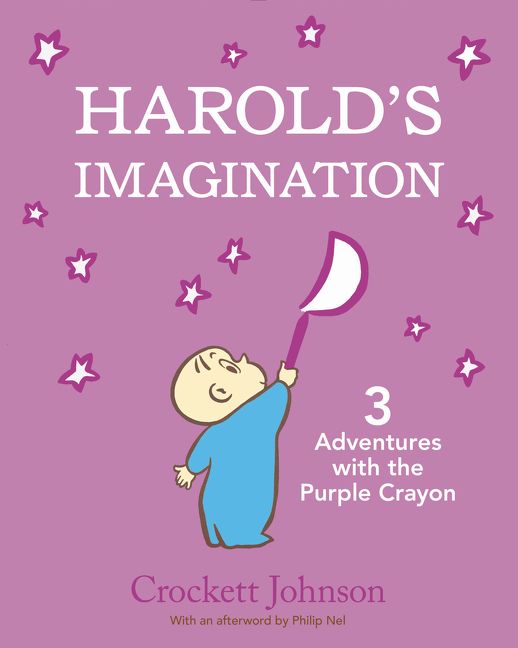
Crockett Johnson, Harold’s Imagination: 3 Adventures with the Purple Crayon. Afterword by Philip Nel. New York: HarperCollins, 2018.
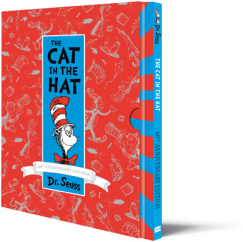
Dr. Seuss, The Cat in the Hat: 60th Anniversary Edition. Foreword by Philip Nel. HarperCollins UK, 2017.
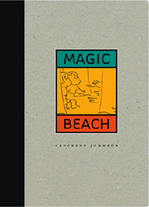
Crockett Johnson, Magic Beach. Appreciation by Maurice Sendak. Afterword by Philip Nel. Asheville, NC: Front Street, 2005. 64 pages. Also available in French translation by Quentin Le Goff: La Plage Magique. Tourbillon, 2006. In German translation by Michael Krüger: Der Zauberstrand. Carl Hanser Verlag, 2007. And in Italian translation by Elena Fantasia: Spiaggia Magica. Orecchio Acerbo, 2013.
- “The book, which was dear to Johnson’s heart, was rejected by numerous publishers in the early 1960s. […] A foreword by Maurice Sendak and an afterword by Philip Nel offer fascinating glimpses both of Johnson and his attempts to get the book published. […] Like the imaginative play of children, the book is mysterious and unexpected but always true to its own inner logic. […] The book itself is beautifully designed and produced, making it a pleasure to handle as well as read. I think Crockett Johnson would approve.” — Terri Schmitz, Horn Book
- “Issued […] in 1965 as Castles in the Sand, with […] illustrations by Betty Fraser, this philosophical tale appears here in its original form, beneath Johnson’s own rough, expressive sketches — sandwiched between an eloquent appreciation of both author and art by Maurice Sendak, and a publishing history by renowned scholar Philip Nel. […] [A] handsomely packaged artifact for adult readers of children’s literature.” — Kirkus Reviews
- “The ingenious book design plays up the feel of an artist’s sketchbook, and the spare pencil sketches (with even the artist’s erasures in evidence) […] give readers the feeling of peering over the artist’s shoulder. The drawings introduce young Ann and Ben, outlined in the expressive line that Harold fans will recognize immediately. The children have only to write a word in the sand and the item appears before them, making an intriguing play on the notion of spelling and spells. […] Like all great stories, this one stretches well beyond the pages. All ages.” — Publishers Weekly
- “Bracketed by two insightful, informative gems for Johnson fans, a two-page ‘appreciation’ by Maurice Sendak and a four-page afterword on the book’s history by Philip Nel, this handsome book is clearly aimed at adults as much as children. But whoever the audience, there is magic to be found in the words and sketches of Crockett Johnson.” — Carolyn Phelan, Booklist
